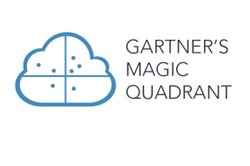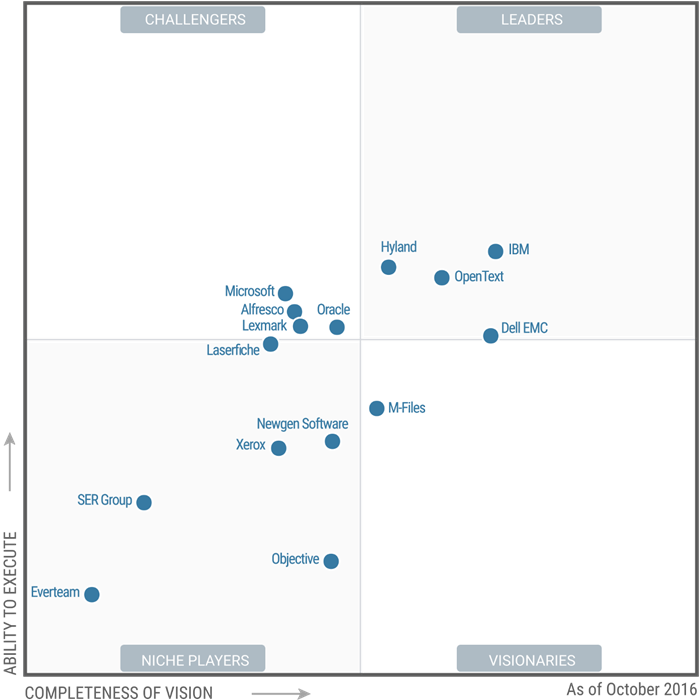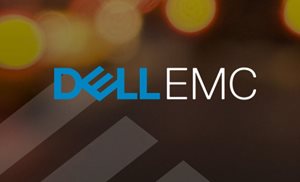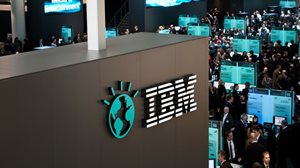Gartner's Magic Quadrant for ECM & The Market Overview
By Venus Tamturk
November 7, 2016
DELL, DELL-EMC, Documentum, EMC, Enterprise, Enterprise Content Management, Forrester, G2crowd, Gartner, Hyland, IBM, Leap, OpenText
As you may recall, last month we discussed how much the little dots had migrated around when Gartner published its annual report, The Magic Quadrant for Web Content Management. Today we will analyze those little dots again but this time, they are wiggling around for the Enterprise Content Management space.
 There is no a new kid on the block this year. However, there are some changes to the inclusion criteria, and those changes have resulted in the number of vendors included having dropped from 20 in 2015 to 15 in 2016 but, we will come back to this. Before diving in to see who got the boot, who lost ground on their competitors, and who jumped from one category to another over the past year, I would like to take a moment to briefly explain the changes from 2015 by criteria as I believe, they tell so much about the direction of the ECM market.
There is no a new kid on the block this year. However, there are some changes to the inclusion criteria, and those changes have resulted in the number of vendors included having dropped from 20 in 2015 to 15 in 2016 but, we will come back to this. Before diving in to see who got the boot, who lost ground on their competitors, and who jumped from one category to another over the past year, I would like to take a moment to briefly explain the changes from 2015 by criteria as I believe, they tell so much about the direction of the ECM market.
The revised criteria:
-
Revenue: The revenue threshold has increased from $13 million (U.S. dollars) in 2015 to $15 million derived from ECM software, with at least 5% of that revenue derived from cloud-based content management services, which is a completely new requirement.
-
Geographic presence: At least 10% of the vendor's overall ECM software revenue must come from outside its home market — if, for example, the vendor has presence in North America and Europe, and North America is its home market, then at least 10% of its ECM software revenue must come from Europe.
-
Functionality: Some of the eight essential functional components of ECM software have been revised. The weight of Image-processing applications is 10% - down from 15% in 2015. The weight of Content workflow is 15% - down from 20%. The weight of Extended components is 20% - up from 15%. Packaged apps, integration and Analytics/BI are the new components with a weight of 5%.
The new criteria:
-
Integration: The vendor's main ECM product must integrate with at least five business applications (ERP, CRM, HR, productivity suite or other business process applications) either natively or through connectors or add-on components.
-
Packaged vertical applications: The vendor must offer packaged applications to at least three vertical markets.
-
Analytics/business intelligence (BI): The vendor must offer content analytics and/or BI capabilities either natively or through integration with analytics engines.
The changes are seen not only in the definition of criteria but also in the definition of the industry. Gartner has updated its description to most accurately define the industry. The analyst firm terms enterprise content management as follows: "ECM is a set of services and microservices, embodied either as an integrated product suite or as separate applications that share common APIs and repositories, to exploit diverse content types, and serve multiple constituencies and numerous use cases across an organization.”

The Leaderboard
In the light of this information, first, let’s have a closer look at the leaderboard. Gartner deposed Microsoft, Lexmark, and Oracle from the leader's quadrant while returning leaders IBM, Hyland, OpenText, and DELL EMC kept hold of their spots.
DELL EMC
Dell EMC has been named a Leader in the Gartner Magic Quadrant for Enterprise Content Management for  the 13th consecutive time. On October 12th 2015, Dell announced it was buying EMC for a record price (for a tech acquisition) of $67 billion. In September 2016, OpenText, Canadian enterprise information management vendor, has agreed to acquire DELL EMC Enterprise Content Division (ECD), including Documentum for $1.62 billion in a deal which is expected to close in early next year.
the 13th consecutive time. On October 12th 2015, Dell announced it was buying EMC for a record price (for a tech acquisition) of $67 billion. In September 2016, OpenText, Canadian enterprise information management vendor, has agreed to acquire DELL EMC Enterprise Content Division (ECD), including Documentum for $1.62 billion in a deal which is expected to close in early next year.
Last week, the Dell-EMC Enterprise Content Division (ECD) made a few announcements during its customer event Momentum, in Barcelona. ECD introduced the Dell EMC LEAP Platform, which is a content management platform featuring a deep set of enterprise-grade content services and announced the availability of Documentum 7.3, which is a new version of its enterprise content management repository.
According to Gartner, the recent releases have focused on modernizing user experiences through mobile support and LOB application integrations. Also, as Dell EMC's platform supports a wide range of vertical and horizontal solutions, Dell EMC's customers are generally satisfied with the products and services they use, as long as they keep up-to-date with the latest software releases.
On the other hand, the research firm warned content managers to review purchase and support terms during contract negotiations to mitigate potential risks due to Dell's acquisition of EMC.
IBM
 The Stamford, Conn.-based research firm cited: “IBM's broad content management ecosystem, on-premises and cloud delivery models with integrated hybrid options, and global reach make it a leading ECM vendor and a preferred vendor for large, global enterprises.” I couldn’t agree more when we consider the IBM portfolio that includes Content Foundation (based on IBM FileNet Content Manager), Content Manager OnDemand (CMOD), Datacap, Enterprise Records, Connections Enterprise Content Edition, Watson Explorer Enterprise Edition and Case Manager.
The Stamford, Conn.-based research firm cited: “IBM's broad content management ecosystem, on-premises and cloud delivery models with integrated hybrid options, and global reach make it a leading ECM vendor and a preferred vendor for large, global enterprises.” I couldn’t agree more when we consider the IBM portfolio that includes Content Foundation (based on IBM FileNet Content Manager), Content Manager OnDemand (CMOD), Datacap, Enterprise Records, Connections Enterprise Content Edition, Watson Explorer Enterprise Edition and Case Manager.
Gartner’s analysts warn the purchasers to consider the full cost of implementation when negotiating with IBM as the wide range of IBM's portfolio amounts to complexity, affects customer infrastructure, cost, time and resource requirements. Another warning is about choosing a Watson product among the various Watson options. Customers should make sure their choice by what will integrate with their ECM tools, as it can be tricky to know which options support ECM use cases.
Hyland
Westlake, Ohio-based Hyland markets its OnBase suite, which is designed for organizations interested in  transaction-associated content and case-centric workloads. The suite is available both on-premises and in the cloud. In 2016, Hyland launched ShareBase, a cloud-based document collaboration, and EFSS solution. However, since the new platform was rolled out for general availability after the cut-off point for evaluation, the authors of the report made their assessments based on only OnBase 15.
transaction-associated content and case-centric workloads. The suite is available both on-premises and in the cloud. In 2016, Hyland launched ShareBase, a cloud-based document collaboration, and EFSS solution. However, since the new platform was rolled out for general availability after the cut-off point for evaluation, the authors of the report made their assessments based on only OnBase 15.
One of the strengths of the platform is its ease of implementation which is one of the factors behind the high customer satisfaction along with the company’s responsiveness to its clients' requirements and product needs.
The report recommends purchasing agents engaging appropriate IT and business stakeholders to ensure they have identified the appropriate options as complex, multifaceted bills of materials and purchasing model "lock-in" can cause a confusion when negotiating new, renewed or upgraded contracts. Additionally, the report also criticized the company’s solution-oriented sales approach as it might not work well with larger organizations.
OpenText
 OpenText, the Waterloo, Ontario-based enterprise information management provider, has been expanding its market reach through new product releases like OpenText Suite 16 and OpenText Cloud 16 and acquisitions such as the buy-out of Dell EMC's Enterprise Content Division, including the Documentum, InfoArchive, and Leap product families.
OpenText, the Waterloo, Ontario-based enterprise information management provider, has been expanding its market reach through new product releases like OpenText Suite 16 and OpenText Cloud 16 and acquisitions such as the buy-out of Dell EMC's Enterprise Content Division, including the Documentum, InfoArchive, and Leap product families.
According to the Magic Quadrant, OpenText Suite 16 is a major advance as it provides a basis for much more flexible access to data, stronger collaboration, and mobile toolsets. The report also speaks highly about OpenText Cloud 16 as it can be deployed either as a pure cloud service or in a hybrid environment.
The report warns prospective customers to check that OpenText can meet their support requirements as frustration with its support process and concerns about upgrading are still seen among its customer base, although OpenText has made progress toward addressing complaints in this regard. Another recommendation to prospective customers is to compare their ECM needs with OpenText's product roadmap as the company has been on an acquisition spree lately.
Vendors Dropped
Fabasoft, an Austria-based software manufacturer and cloud provider, did not meet Gartner's new geographic presence criterion that requires at least 10% of a vendor's revenue in this market to come from outside its main region and the new criterion named packaged vertical applications, which is explained above.
Siav, the first Italian company in the field of Enterprise Content Management, got the boot from the Magic Quadrant 2016 for the same reasons as Fabasoft.
As Software Innovation, a Scandinavian ECM provider, declined to participate in Gartner’s 2016 Magic Quadrant surveys of vendors and reference customers, due to merger and acquisition activity, the search firm relied on a combination of the 2015 data and subsequent publicly available data. As a result, the vendor didn’t meet the criteria, particularly with regard to integration with business solutions and content analytics.
Systemware, an Addison, Texas-based ECM provider, did not meet Gartner's new geographic presence criterion that requires at least 10% of a vendor's revenue in this market to come from outside its main region. As Systemware reported all of its revenue coming from a single region (North America), it became ineligible
Upland Software, delivering cloud-based project, portfolio and work management software applications for enterprise, did not meet Gartner's new geographic presence criterion that requires at least 10% of a vendor's revenue in this market to come from outside its main region, packaged vertical solutions, content analytics (it offers only usage analytics), and integration with common business and productivity solutions.
Market Overview
According to Gartner, the ECM market grew by 9.4% in 2015 to a worldwide revenue total of $5.9 billion in constant currency. That compares with a 2014 growth rate of 6.2% and a worldwide revenue total of $5.4 billion. The top-three vendors lost market share in 2015, while their smaller rivals gained.
Another interesting finding Gartner retrieved from the report is that best-of-breed, local and multinational vendors accounted for 33.8% of the market in 2015, up from 27.9% in 2013, while cloud offerings accounted for over 8% of the market's revenue, up from approximately 5% in 2014.
According to MarketsandMarkets, the ECM market size is expected to grow from USD 28.10 Billion in 2016 to USD 66.27 Billion by 2021, at a Compound Annual Growth Rate (CAGR) of 18.7% during the forecast period.
Asia-Pacific
The Asia/Pacific (APAC) region is by far the fastest-growing market for enterprise content management (ECM) solutions.
Opportunities:
-
A focus on real-time analytics without the baggage or legacy of any existing ECM solution.
-
The demand for integrated analytics and ECM is rapidly emerging. Gartner sees this demand as the intent to drive forward into the era of an algorithmic business supported by a digital workplace.
-
As always, the rapid adoption of the latest smartphone or phablet devices is the most consistent and predictable trend in this region. Knowing that an inherent culture of collaboration is another strong characteristic attribute of the region, offering the smarter content capabilities, such as creating, editing, approving or sharing documents while on the go is becoming a must for the ECM vendors, and has become a mainstream for the vendors in this particular region. Therefore, it is recommended to have a strong digital workplace vision for ECM vendors in APAC.
Threats:
-
Bandwidth limitations, particularly in remote locations, although modernization of telco infrastructures (such as Digital India's initiatives) are expected to improve this situation.
-
Enforcement of an ECM discipline, which is often an uphill battle because of the absence of governmental policy or regulation.
Europe
The European ECM market actually shrank by 6.8% during 2015, compared to growing 6.3% in the U.S. and 1.4% worldwide. Within Europe, there were differences: many nations including Germany and France showed a market decline of more than 10% and only a small number of markets showed any growth. For example, the U.K. market grew just 2%. Most Western European economies have not yet returned to the ECM investment levels seen before the 2009 financial crisis.
Opportunities:
-
The industry-specific ECM solutions in verticals such as financial services, life sciences, and construction are one of the major considerations for European organizations.
-
Cloud-based ECM is a sensitive area in the region as the organizations consider the extent to which they embrace public cloud offerings and cloud office, while still having a control over sensitive content and acting in accordance with European and national regulations and legislation.
-
The fact that Europe has many different languages currently provides regional or national vendors the opportunity to concentrate on meeting the demands of local markets. However, if the large global vendors consider expanding their selections of language, that would give them an edge.
-
In the European market, the demand for open-source software is growing, especially in the public sector. Gartner also notes that the EU has an equal treatment policy for open-source solutions for internal systems, and there is a general preference from the U.K. government digital services for open-source software.
Threats:
-
Since there is no Europe-wide regulation for records management, the need for acting in accordance with standards and regulations varies across Europe by geography and industry sector. On the flip side, many organizations are using a standard provided by MoReq2010 as a starting point in their specification of ECM capabilities.
-
Another challenge of the region is the big demand for specialized applications. Particularly, small and midsize businesses (SMBs) often work with a range of applications that focus on common business processes local to their sector and region. Therefore, the organizations consider the vendors which have a good understanding of, and experience with, these specialized applications as they can help clients implement and integrate their ECM capabilities more efficiently, and with less risk.
-
According to Gartner, a distinguishing attribute of the European market is that many customers still prefer to receive local, face-to-face support. It might be a serious road block for international vendors who lack local support or work through partners with limited expertise.
Gartner’s Crystal Ball
Lastly, I would like to touch upon Gartner’s two-year predictions. By 2018, the firm expects to see:
-
Half of the enterprises will manage content on hybrid systems (cloud/on-premise).
-
More than one-fifth of businesses will be managing content from multiple organizations.
-
File synchronization and sharing will be a standard built-in ECM function.
-
Half of big-name ECM vendors will re-architect their software to be cloud-based.
-
One-fifth of business content will be machine authored.
For businesses, it’s imperative to have the right players and plan in place, considering every organization has its own unique needs and goals to meet. Therefore, industry reports like the G2 Crowd’s Reports, the Gartner’s Magic Quadrant (MQ) Reports, the Forrester’s Wave Report, and so on are definitely beneficial to guide companies that are in the process of evaluating a Web Content Management solution for their business, as these reports provide an in-depth analysis of leading vendors. However, as I always say, businesses shouldn’t limit themselves to vendors on these reports, rather they should do a thorough assessment for their needs to achieve their goals and research what solutions exist in the market that can fit into their workflow.


Venus Tamturk
Venus is the Media Reporter for CMS-Connected, with one of her tasks to write thorough articles by creating the most up-to-date and engaging content using B2B digital marketing. She enjoys increasing brand equity and conversion through the strategic use of social media channels and integrated media marketing plans.